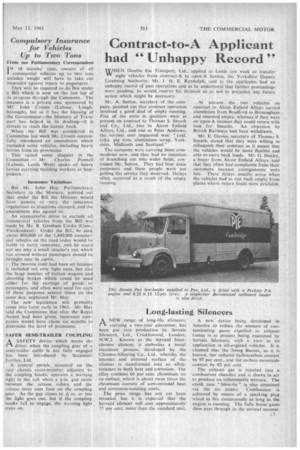Compulsory Insurance fir Vehicles Up to Two Tons
Page 39

If you've noticed an error in this article please click here to report it so we can fix it.
From our Parliamentary Correspondent I N 18 months' time, owners of ail cornmercial vehicles up to two tons unladen weight will have to take out insurance against injury to passengers.
They will be required to do this under a Bill which is now on the last lap of its progress through the Commons. The measure is a private one, sponsored by Mt. John Cronin (Labour, Loughborough), but as it has the blessing of the Government—the Ministry of Transport has helped in its drafting—it is certain to reach the statute book.
When the Bill was considered in Committee last week Mr. Cronin successfully introduced an amendment which excluded some vehicles, including heavy lorries from its provisions.
This raised some disquiet in the Committee — Mr. Charles Pannell (Labour, Leeds West) spoke of heavy lorries carrying building workers or hoppickers.
Insurance Variations , But Mr. John Hay, Parliamentary • Secretary to the Ministry, pointed out that under the Bill the Minister would have powers to vary the insurance regulations as situations changed, and the amendment was agreed to, An unsuccessful move to exclude all commercial vehicles from the Bill was made by Mr. R. Gresham Cooke (Cons., Twickenham). Under the Bill, he said, about 800,000 of the 1,400,000 commercial vehicles on the road today would he liable to carry insurance, and he could not see why a small retailer's van which ran around without passengers should be brought into its ambit.
The two-ton limit had been set because it included not only light vans, but also the large number of station wagons and shooting brakes which could be used either for the carriage of goods or passengers, and often were used for each of these purposes several times on the same day. explained Mr. Hay.
The new legislation will probably come into force early in 1963. Mr. Hay told the Committee that after the Royal Assent had been given, insurance companies would have about six months to determine the level of premiums.
SAFER SEMI-TRAILER COUPLING
I-1 A SAFETY device which warns the driver when the coupling gear of a semi-trailer outfit is not fully engaged has been introduced by Scammell Lorries, Ltd.
A control switch, mounted on the rear chassis cross-member adjacent to the coupling hooks, operates a warning light in the cab when a +-in. gap exists between the release rollers and the release lever cam face on the coupling gear. As the gap closes to sag-in. or less the light goes out, but if the coupling hooks fail to engage, the warning light stays on.
























































































































